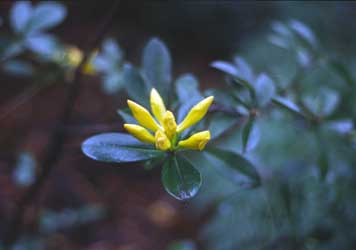
"Learn to grow azaleas and rhododendrons to perfection"
Understand Azaleas and Rhododendrons, their cultivars and cultivation; and in doing so, provide a foundation upon which you can better pursue your interest in this fascinating group of plants.
Rhododendrons are popular garden plants in all types of gardens, all around the world. They are grown in lots of different ways, and in lots of different types of gardens. It is important to select an appropriate cultivar for the purpose at hand.
- Some are great as rockery plants and others are not.
- Some are ideal as a screening plant.
- Many grow well on a sunny border; but others are better suited to grow in a shaded as a woodland
- Some grow better in pots than others, certain cultivars are very popular for bonsai and others for creating topiary.
Lesson Content
There are eight lessons as outlined below, in this course, each requiring about around 10 or more hours of work. Overall, the course can be completed in around 100 hours.
- Introduction.
- Culture
- Propagation.
- The most Commonly Grown Varieties of Azaleas.
- Most Commonly Grown Varieties of Rhododendrons.
- Lesser Grown Varieties.
- Making the best use of these plants.
- Special Assignment. On one selected plant or group.
Duration 100 hours
Course Aims
- Describe the classification of the genus Rhododendrons
- Describe common cultural needs relative to all Rhododendron species.
- Propagate and explain the materials and techniques used for propagation of Azaleas and Rhododendrons.
- Describe a range of commonly cultivated species of Rhododendrons and Azaleas.
- Undertake research into lesser known varieties of Rhododendron and Azalea.
- Determine how to use rhododendrons in a home garden or other landscape situation.
- Discuss in detail at least one specific group or individual plant in the Rhododendron genus.
What is the Difference between Azaleas and Rhododendrons?

Azaleas are actually just small varieties of rhododendrons. They can be either evergreen or deciduous and usually grow no more than 1-2 metres in diameter.
Azaleas grow well throughout temperate climates, but extremes of humidity are a problem in excessively dry or humid locations.
The most widely grown azaleas are Indica Hybrids. These are evergreen, sometimes tender, small shrubs derived mostly from R. indicum, R. mucronatum, and R. Simsii. Flower colours include white, pinks, reds, mauves, and purples. Single flowered Indicas are usually quite hardy, and have a tall upright habit growing to 3m tall. Foliage remains fairly dense, with bristly lanceolate leaves and hairy stems. Flowering generally begins in the spring and lasts for about three weeks. Double or semi-double flowering Indicas are available in a wide range of flower sizes, shapes and colours such as pinks, reds, mauves, purples. Flowers may also be striped or flecked. Indicas vary considerably in their degree of hardiness, height and competitiveness. There is also wide variation in the length of the flowering season, with some carrying odd blooms over the summer with peak flushes in spring or sometimes autumn, while others have only a spring flush: A. indica ‘Gretel’.
The classification of rhododendrons has been made difficult due to the vast number of species in this genus. Consequently, there have been many revisions over the years. There are estimated to be more than 800 species of Rhododendron comprising of evergreen, semi-deciduous, and deciduous shrubs and trees. This figure does not take into account subspecies, cultivars, and naturally occurring varieties. They are native chiefly in the temperate areas of the Northern Hemisphere, most abundant in the Himalayas.
Rhododendrons come from both tropical and temperate climates.
Cool climate rhododendrons are more commonly grown in temperate climates.
Tropical Rhododendrons (also called Vireyas), are naturally epiphytic and need excellent drainage. In their natural environment, these plants are subject to reasonably bright light, warm midday and cold evening temperatures (to 0 degrees C) in the cloud forest of mountain tops. Problems have been noted if grown in the ground of plastic pots. Perfect drainage is essential. The use of terracotta pots reportedly provides the best environment for the roots as the porous pot structure aids in the removal of excessive moisture. Do not use saucers. Large pots are also best avoided as this can cause stress in the plant. When these plants are stressed, it can result in increased flowering and affect growth habit. In the ground, they are best planted in raised garden beds, where they are either in light shade all day, or at least from mid-morning onwards. Vireyas will grow (though not as well) in cool climates, perhaps under the eves of a house or under the canopy of large trees where the light is filtered and there is some protection from extreme cold. Excessively shaded places can simply remain too cold for the plants to ever show any appreciable growth.
WHAT NEXT?
Register to Study - Go to “It’s Easy to Enrol” box at the top of the page and you can enrol now.
or
Get Advice – Email us at info@acsedu.co.uk OR
Use our FREE COUNSELLING SERVICE to contact a tutor
CLICK TO CONTACT US